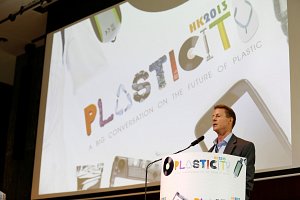200+ attend Plasticity Hong Kong, innovative solutions highlighted
By Bob Moser
Published on 10 June 2013

The second inaugural Plasticity conference wrapped up in Hong Kong last week, leaving industry innovators inspired to address the question of how to address the future use of plastic in a sustainable manner.
Every year a staggering 280 million tons of plastic is produced globally, yet it’s estimated that only 10 percent each year is actually recycled. Capturing this waste stream presents a significant and untapped business opportunity, as does the redesign of packaging, and the thought process around waste creation.
Provoking discussion between key industry thought leaders, game changers and visionaries alike, the conference hosted more than 200 guests who flew from all around the world to take part in the conversation.
“This is the 2nd Plasticity event we have hosted, with the first at the Rio+20 Earth Summit last year, and the interest was incredible,” said Doug Woodring, event founder. “This is a unique business event about the future of plastic, and how companies, communities and governments can work together to create new business models and opportunities that can use the vast waste resources that we create each day in our respective countries. It is a dialogue that is not happening enough around the world, as the opportunities for new business models are large. Hong Kong, for example, creates at least 1,700 tons of waste plastic per day, yet with an under-organized infrastructure to capture the value of this waste stream.”
Phil King of Method said, “You could have a perfectly sustainable idea but if you can’t find the partners to help turn that idea into a product and, thereafter, to make that product into a commercial success, then we think that you’re not truly innovating. Plasticity is so exciting because it brings together a broad range of great minds across different areas in the same place at the same time. For Method that’s a rich environment for sharing ideas and creating partnerships which can ultimately help solve the challenges in designing and bringing to market sustainable products which people love and want to use.”
Dr. Mike Biddle, Founder of MBA Polymers, said, “Since the Plasticity event last year, a ‘Perfect Storm’ for plastics recycling has begun to brew and it’s a great opportunity to bring people together via the Plasticity Forum in Hong Kong to discuss how to navigate the storm to maximize opportunities to reduce plastics waste.” Factors driving the storm include:
— China has initiated what is being called ‘Operation Green Fence’ whereby China customs is significantly clamping down on enforcement of import restrictions on scrap and essentially saying to the world to stop sending us waste and start sending resources.
— At the same time, collection rates for end of life ‘stuff’ containing plastics are on the rise around the world at the community and producer levels
— A growing number of large manufacturers are looking to increase their use of recycled plastics. This is being driven by “market access” standards such as EPEAT (www.EPEAT.net) as well as the perception among a growing number of brands that consumers are making more decisions based on sustainability criteria, including recyclability and recycled content.
— Manufacturers are also beginning to look at “closing-the-loop” as both a way to win and keep customers as well as hedging the security of their supply chains from the upward march of raw material costs.
— And the US EPA just cleared the way for recyclers to “mine” plastics from the approximate 5 million tons of shredder residue that are landfilled annually in the US.
Re-imaging the future of plastics, key topics included:
— Closing the plastic loop yields significant benefits, in many ways. Consumer goods behemoth Unilever has realized savings to the tune of more than $256 million from efficient use of materials and plastic waste capture since 2008.
— Bioplastics today account for a small proportion of total plastics usage – less than 1 percent by one estimate. Global bioplastics capacity is projected to grow almost five-fold by 2016, to 5.78 million metric tons, but with wide regional disparities. Asia and South America will take the lion’s share of growth, while North America will see more modest gains.
— Bio-based plastics have had relatively little penetration into durable goods, and this makes up a sizable proportion of total plastics use. In addition, across almost all material and application categories, landfill rates remain at or close to 100 percent.
— The environmental impacts of plastics are currently not included in the price. The average total “ecocosts” of the production of thermoplastic virgin materials, for instance, is approximately 1 euro/kg (based on Eco-Costs approach), which is comparable to the current returns on the material.
— The business opportunity for the circular economy is estimated at 290 – 490 billion euros for Europe alone. BIOIS has furthermore estimated that full implementation of general EU waste legislation could save 72 billion euros a year, increase the annual turnover of the EU waste management and recycling sector by 42 billion euros, and create over 400,000 jobs by 2020. In the U.S., an annual materials saving of $7.3 billion and a profit of $2.4 billion – approximately $200 per ton of plastic collected – could be achieved by separating and recycling five main high volume plastics.
— As You Sow, a shareholder advocacy organization, estimated the value of discarded post-consumer packaging being buried in U.S. landfills – valuable material like aluminum, cardboard and PET – at US$11.4 billion in 2010.
Update: Industry news site Plastics.com has since linked to our summary of the event.
